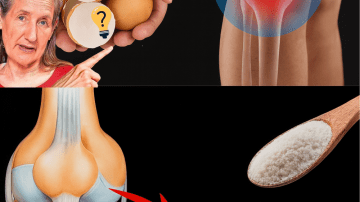Sleep is your body’s nightly reset, a sacred time when it heals, recharges, and prepares for the day ahead. But what if the way you sleep—specifically, curling up on your right side—could be quietly sabotaging your health? While it might feel cozy and natural, research reveals that sleeping on your right side may come with surprising downsides, from digestive woes to heart strain and nagging muscle pain. This isn’t just about comfort; it’s about how your sleep posture shapes your long-term wellness. Dive into this exploration of why your right-side slumber might be doing more harm than good and discover simple tweaks to transform your rest into a powerhouse of health.

Why Your Sleep Position Matters More Than You Think
Every night, you make an unconscious choice about how your body rests for hours. That choice—your sleep position—can influence everything from your digestion to your heart health. While many of us gravitate toward sleeping on our right side for comfort, science suggests this habit may carry hidden risks that accumulate over time. Understanding these effects isn’t just about avoiding discomfort; it’s about unlocking better sleep and safeguarding your health for years to come. Let’s break down the key ways sleeping on your right side impacts your body and what you can do to rest smarter.
🩺 Acid Reflux: The Silent Nighttime Saboteur
One of the most significant drawbacks of sleeping on your right side is its connection to acid reflux, a condition that can turn restful nights into restless battles. When you lie on your right side, gravity pulls your stomach’s contents toward your esophagus, making it easier for gastric acids to creep upward. This can trigger that all-too-familiar burning sensation, disrupt your sleep, and leave you groggy the next day. For those with gastroesophageal reflux disease (GERD), gastritis, or chronic heartburn, this position can be especially problematic, amplifying symptoms and robbing you of restorative rest.
By contrast, sleeping on your left side keeps your stomach below your esophagus, creating a natural barrier against acid backflow. Studies consistently show that left-side sleeping reduces reflux episodes, offering relief for those prone to nighttime discomfort. If you’re waking up with a sour taste or chest pain, your sleep position might be the culprit.
Tips to Combat Nighttime Acid Reflux:
- Elevate the head of your bed by 6–8 inches to keep acid where it belongs.
- Skip heavy, late-night meals that overload your stomach before bed.
- Experiment with left-side sleeping to see if it eases your symptoms.
Making these small changes can mean the difference between waking refreshed or battling heartburn all night. Your digestive system will thank you.
❤️ Heart Health: Is Your Right Side Putting Pressure on Your Ticker?
Your heart works tirelessly, even while you sleep, but sleeping on your right side might add unnecessary strain. Research suggests this position can place subtle pressure on your heart, particularly for those with pre-existing cardiac conditions like heart failure or hypertension. While healthy individuals may not notice immediate effects, over time, this added stress could contribute to discomfort or exacerbate underlying issues.
The mechanics are simple: when you lie on your right side, your heart shifts slightly toward the right side of your chest, potentially compressing nearby structures. This can subtly affect blood flow and heart function, especially in those with compromised cardiovascular health. For people with heart conditions, sleeping on the right side may lead to increased symptoms like shortness of breath or palpitations during the night.
Beyond the heart itself, this position can also hinder circulation. Efficient blood flow is critical during sleep, as it supports nutrient delivery and waste removal. Sleeping on your right side may impede optimal circulation, potentially leading to fluid retention or that heavy, sluggish feeling in your limbs when you wake. For those concerned about heart health or swelling, rethinking your sleep posture could be a game-changer.

How to Support Your Heart While You Sleep:
- Consider sleeping on your left side to reduce pressure on your heart.
- Use a supportive mattress to maintain proper spinal alignment and ease circulation.
- Consult a doctor if you experience nighttime symptoms like chest discomfort or swelling.
Small adjustments to your sleep routine can create a heart-friendlier environment, helping you wake up energized and ready to tackle the day.
💪 Muscle and Joint Pain: The Morning Aches You Didn’t Expect
Ever wake up with a stiff shoulder, tingling arms, or an achy lower back? If you’re a right-side sleeper, your position might be to blame. Sleeping on your right side places uneven pressure on your shoulder, hip, and spine, leading to muscle stiffness and joint discomfort over time. This is especially true if your mattress or pillow fails to provide adequate support, leaving your body misaligned for hours.
The shoulder you rest on bears the brunt of your body weight, which can compress nerves and cause that pins-and-needles sensation in your arm. Meanwhile, your hips and lower back may twist slightly, contributing to chronic pain or stiffness. Over months or years, this repetitive strain can lead to musculoskeletal issues, making mornings feel more like a workout recovery than a fresh start.
Ways to Ease Muscle and Joint Discomfort:
- Invest in an orthopedic pillow to keep your neck and spine aligned.
- Place a pillow between your knees to reduce hip and lower back strain.
- Alternate between sleeping on your left and right sides to balance the load on your joints.
By prioritizing proper support and varying your sleep position, you can minimize morning aches and protect your body from long-term wear and tear.
🩻 Circulation and Lymphatic Drainage: The Hidden Connection
Your body’s circulatory and lymphatic systems work overtime during sleep to detoxify, repair, and restore. However, sleeping on your right side may hinder these processes. The position can subtly compress blood vessels and lymphatic pathways, slowing the flow of fluids. This may lead to morning swelling, particularly in your arms or legs, and a general sense of heaviness when you wake.
Efficient lymphatic drainage is crucial for removing toxins and reducing inflammation. When circulation is compromised, you might notice puffiness, sluggishness, or even a foggy mind in the morning. For those with conditions like lymphedema or poor circulation, right-side sleeping could worsen these issues, making it harder for your body to perform its nightly maintenance.
Tips for Better Circulation During Sleep:
- Elevate your legs slightly with a pillow to encourage blood flow.
- Stay hydrated during the day to support lymphatic function.
- Try sleeping on your back or left side to optimize circulation.
These simple tweaks can enhance your body’s ability to detox and recover, leaving you feeling lighter and more refreshed each morning.
😴 So, What’s the Best Sleep Position?
While sleeping on your right side might feel instinctive, the evidence points to potential drawbacks for your digestion, heart, muscles, and circulation. So, what’s the alternative? For many, sleeping on the left side emerges as a healthier choice. It reduces acid reflux, eases pressure on the heart, and supports better circulation. However, it’s not a one-size-fits-all solution—some people may find left-side sleeping uncomfortable or impractical.
Sleeping on your back can also be a great option, especially with a slight elevation of the head to minimize reflux and snoring. However, back sleeping may worsen sleep apnea or lead to snoring in some individuals, so it’s worth experimenting to find what works for you. The key is to prioritize a position that aligns your spine, supports your joints, and minimizes strain on your vital systems.
How to Find Your Ideal Sleep Position:
- Test different positions over a few nights to see what feels best.
- Use pillows strategically to support your neck, knees, or lower back.
- Invest in a mattress that contours to your body without sinking too deeply.
Your perfect sleep posture is one that leaves you waking up refreshed, pain-free, and ready to seize the day.

🌙 Transform Your Sleep, Transform Your Health
The way you sleep is more than a habit—it’s a powerful lever for your health. Sleeping on your right side may seem harmless, but its effects on acid reflux, heart health, muscle comfort, and circulation reveal a different story. By understanding these hidden risks, you can make informed choices to optimize your rest and protect your long-term wellness.
Start small: try shifting to your left side, adding a supportive pillow, or elevating your bed to see how your body responds. These adjustments might feel minor, but they can lead to profound improvements in how you feel each morning. Your body works hard to keep you thriving—give it the sleep environment it deserves.
By rethinking your sleep position and making intentional changes, you’re not just improving your nights; you’re investing in better days. So tonight, as you settle in, ask yourself: is your sleep posture helping or hurting you? The answer might just inspire a change that transforms your rest—and your life.






